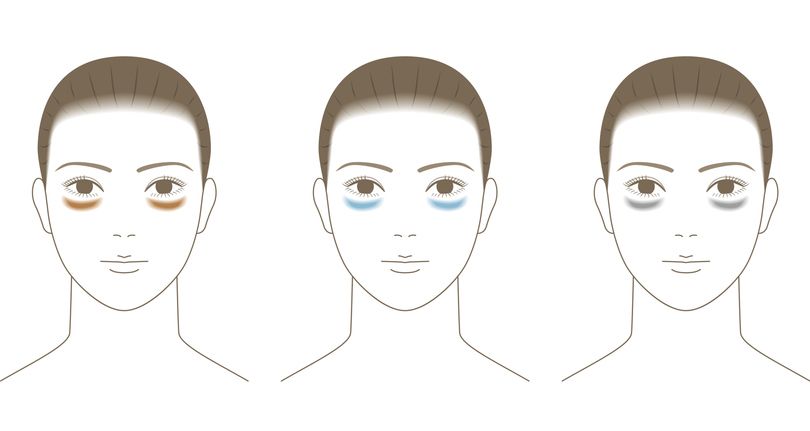
Author: Natalie Ng|Updated: 5 June 2025
If you’ve ever looked in the mirror and noticed dark circles under your eyes, you probably blamed a lack of sleep. Although that’s a common reason, it’s not the only one. Orbital dark circles can show up due to a lot of reasons. Your genes, your skin’s reaction to allergies or sun exposure may be causing them. Sometimes it comes down to how your facial fat shifts over time or changes in your skin’s texture and tone. The amount of water you drink or how often you’re staring at a screen can make a difference. These dark shadows around the lower eyelid aren’t always easy to figure out. They can come from pigment, blood vessels, or the way the skin sinks slightly with age. Due to different causes, there’s no one-size-fits-all fix either. Want to know what’s really behind your orbital dark circles? Keep reading—we’re breaking down seven reasons they show up, so you’ll have a clearer picture of what’s going on and what can help.

Cause of Orbital Dark Circles 1: Genetic Predisposition and Hereditary Factors

Inherited traits that lead to orbital dark circles
If dark circles run in your family, genetics could be the reason. A genetic predisposition often plays a big role in the appearance of orbital dark circles, regardless of how much sleep you get or how well you care for your skin.
You may inherit thinner periorbital skin, which makes the blood vessels underneath more visible. This can lead to vascular dark circles, especially around the lower eyelid. Some people also naturally have a deeper tear trough or more defined infraorbital rim, which casts shadows and adds to the darkened appearance. In some cases, there’s less facial fat in the area from the start, or facial fat descends earlier with age, which can lead to more noticeable hollowing.
Another inherited factor is increased melanin production in the periorbital region. This often causes pigmented dark circles, linked to melanin deposition, dermal pigmentation, or even postinflammatory hyperpigmentation.
Treatment for inherited dark circles
While you can’t change your genetics, there are treatment modalities that can help reduce the appearance of dark circles. If pigmentation is the main concern, topical treatments like vitamin C, kojic acid, azelaic acid, or glycolic acid may help. For volume loss or structural hollowing, options like fat grafting, autologous fat transplantation, or chemical peels may be more effective. Vascular causes may respond better to laser therapy or intense pulsed light. A proper medical evaluation can help you figure out which treatment options fit your skin and structure best.

Cause of Orbital Dark Circles 2: Dehydration and Poor Fluid Balance

Fluid imbalance increases orbital dark circles
Not drinking enough water during the day can make dark circles look worse. When your body is dehydrated, the skin under your eyes tends to look more hollow and dull. The periorbital skin is already thin, so any fluid imbalance makes the area more prone to darkening.
Dehydration also affects blood circulation. When fluid levels drop, blood vessels under your eyes may stand out more, creating a darker, tired look. At the same time, the body might try to hold on to water, which can cause puffiness and make shadowing more noticeable.
Another sign of poor hydration is a loss of skin elasticity, especially around the eyes. Without enough water and electrolytes, the periorbital area can appear sunken, and the darkened appearance becomes more visible due to changes in how light reflects off the surface.
Treatment for dehydration-related dark circles
Improving your fluid balance supports better circulation and skin health. Regular hydration helps maintain skin elasticity and may reduce the look of dark circles caused by shadowing or visible blood vessels. Alongside drinking water, maintaining electrolyte balance is helpful for supporting the skin's structure and appearance, especially in delicate areas like the infraorbital region. While this may not treat pigmented dark circles or facial hollowing, it can reduce the appearance of vascular causes linked to dehydration.
Read More
Book Now to Experience
Miracle Eye Rescue Treatment
1 Minute Self-Registration
Date should not be before minimal date

Cause of Orbital Dark Circles 3: Allergies and Seasonal Sensitivities

Allergic responses increase periorbital dark circles
Allergies can make orbital dark circles look darker and more swollen. When you're exposed to allergens like pollen, dust, pet dander, or mold, your body releases histamines. These cause blood vessels under the eyes to dilate, making them more visible through the thin periorbital skin. The result is often vascular dark circles with a bluish or purplish tint.
Nasal congestion from allergies can also slow down blood flow in the infraorbital area. This builds pressure in nearby vessels, contributing to swelling and the darkened appearance under your eyes. The more inflamed the tissue becomes, the more shadowing shows up.
Another issue is eye rubbing. Itching is common during allergic reactions, and rubbing your eyes can break tiny capillaries, leading to postinflammatory hyperpigmentation and worsening periorbital hyperpigmentation.
Environmental triggers and their long-term impact
Some allergens are seasonal—like grass, tree, or ragweed pollen—while others, such as dust mites or mold, can affect you year-round. Repeated exposure and chronic inflammation around the eyes can result in pigmentation irregularities and a more pronounced shadowing effect over time. For many people, allergic shiners—dark circles linked to nasal congestion and allergic reactions—are a regular part of allergy flare-ups.

Cause of Orbital Dark Circles 4: Age-Related Volume Loss

Fat loss deepens the appearance of orbital dark circles
As you get older, the fat pads under your eyes gradually shrink and shift. This reduction in infraorbital fat changes the way light hits your face, creating shadows that make dark circles look deeper and more defined. When facial fat descends or thins out, the support beneath the periorbital skin weakens, leaving the area looking hollow.
The infraorbital fat pad normally acts as a cushion beneath the eyes. As this fat diminishes, blood vessels and subdermal features become more visible through the thin skin. This leads to a mix of vascular dark circles and structural hollowing. The tear trough area becomes more noticeable too, forming a curved indentation that casts a shadow across the under-eye area.
This type of volume loss often starts in your late twenties or thirties and becomes more visible in your forties. It’s one of the most common age-related causes of periorbital dark circles.
Bone changes contribute to under-eye hollows
Along with fat loss, bone resorption also plays a part. The bony structure of your face, including the infraorbital rim and cheekbones, recedes over time. As the bone shrinks back, the skin and remaining fat lose support, creating a sunken look that enhances shadowing under the eyes.
This structural shift increases the depth and visibility of the tear trough and lower eyelid area. The result is a darker and more hollow appearance—even when you’re well rested.
Treatment modalities for this type of dark circle include dermal fillers to restore volume, fat grafting for longer-term correction, or autologous fat transplantation in more severe cases. These options aim to replace lost support and reduce the shadowing effect caused by facial hollowing and bone changes.
Book Now to Experience
Miracle Eye Rescue Treatment
1 Minute Self-Registration
Date should not be before minimal date

Cause of Orbital Dark Circles 5: Iron Deficiency and Nutritional Gaps

Low iron levels increase visibility of dark circles
Iron deficiency is a lesser-known but important factor behind orbital dark circles. When your iron levels drop, your blood carries less oxygen. This can make your skin—especially in the periorbital area—look paler and thinner, which makes the underlying blood vessels stand out more. The result is a darker, more shadowed appearance under the eyes.
Pale skin also reduces contrast between your skin tone and the bluish tint of veins beneath it, making vascular dark circles more noticeable. In some cases, these circles may appear even when you're well-hydrated and rested, simply because the tissue isn't getting enough oxygen.
Iron deficiency often shows up with other nutritional imbalances that can affect skin tone and elasticity, which adds to the appearance of darkened under-eyes.
Other nutrient deficiencies that affect orbital skin
A lack of essential vitamins can also make orbital dark circles worse:
• Vitamin C is important for collagen production. Without enough of it, your skin becomes thinner and less firm, which can expose underlying blood vessels and contribute to the shadowing effect.
• Vitamin K plays a role in blood clotting and capillary health. Low levels may lead to minor blood leakage under the skin, contributing to dermal pigmentation and uneven coloring.
• Vitamin B12 supports oxygen circulation in the body. When levels are low, skin cells may not get enough oxygen, leading to a darker tone around the eyes.
These deficiencies don’t always cause dark circles on their own, but they often work together with other factors like facial fat loss or thin periorbital skin to make circles under the eyes more visible.
Before taking supplements, it’s best to get a medical evaluation or blood test to identify specific gaps. Correcting nutrient levels may help improve your skin’s overall appearance and reduce the darkened look under the eyes.

Cause of Orbital Dark Circles 6: Eye Strain and Digital Device Usage

Prolonged screen time worsens infraorbital dark circles
Spending long hours looking at screens can lead to visible changes in the orbital area. When your eyes are focused on digital devices, you tend to blink less often, which leads to dryness and irritation. This can increase tension in the orbicularis oculi muscle around the eyes, making dark circles more pronounced over time.
Eye strain also affects blood flow. Staring at screens for extended periods can cause the small blood vessels around your eyes to dilate. This makes vascular dark circles more visible through the thin periorbital skin. The lower eyelid area is especially sensitive to these changes, since it’s already prone to showing signs of fatigue or poor circulation.
This kind of strain can affect people of all ages, and the more time you spend on phones, laptops, or tablets—especially without breaks—the more likely these changes are to show up around your eyes.
Sleep disruption and muscle tension around the eyes
Blue light from screens can also interfere with your sleep cycle, especially if you use devices late at night. Poor-quality sleep doesn’t just make you feel tired—it can also contribute to a dull or darkened appearance under the eyes, particularly in the infraorbital area. Over time, this leads to a tired, sunken look that may become a regular feature rather than something that goes away with rest.
Squinting at screens—especially in dim lighting—also causes muscle fatigue in the face. This creates more tension around the eye area, which can weaken the surrounding periorbital skin and increase the appearance of dark circles.
Regular breaks, adjusting screen brightness, and following habits like the 20-20-20 rule can help reduce this kind of eye strain. While screen time won’t cause structural changes like facial fat loss, it can still make existing dark circles stand out more due to vascular causes and muscle-related tension.
Book Now to Experience
Miracle Eye Rescue Treatment
1 Minute Self-Registration
Date should not be before minimal date

Cause of Orbital Dark Circles 7: Sun Exposure and Melanin Production

UV exposure increases pigmentation around the eyes
Spending time in the sun without protection can darken the skin around your eyes. The orbital area is especially sensitive because the skin here is thinner and more transparent. When exposed to UV rays, your body produces more melanin to shield the skin. This natural defense leads to pigment deposition that often shows up as pigmented dark circles.
Over time, repeated sun exposure in this area contributes to periorbital hyperpigmentation. The more melanin your skin produces, the more likely it is to develop uneven coloration in the periorbital region. The result is a darker, more shadowed appearance—especially noticeable around the medial canthus and under the lower eyelid.
Prolonged UV damage can also thin the skin further by breaking down collagen and elastin. This loss of structure reveals more of the vascular network beneath, combining both pigment-based and vascular causes of dark circles.
Uneven melanin response creates patchy dark circles
Melanin synthesis isn’t always uniform. Even short periods of sun exposure can trigger uneven melanin production around the eyes, causing irregular patches of darkness. These blotchy patterns often make dark circles more noticeable, especially in areas where the skin has previously been inflamed or irritated.
Past skin conditions such as atopic dermatitis or postinflammatory hyperpigmentation can also lead to lingering pigmentation irregularities in the orbital region. This creates a darker and uneven skin tone that’s harder to conceal and slow to fade.
To reduce these effects, sun protection around the eyes is essential. While treatments like chemical peels (e.g., lactic acid or trichloroacetic acid), topical agents (kojic acid, azelaic acid), and laser therapy can help, avoiding sun exposure remains one of the most effective ways to prevent further pigment buildup and protect the periorbital skin.

Types of Orbital Dark Circles

Different types of dark circles show up in different ways
Not all dark circles are the same. Some are caused by pigment in the skin, others by visible blood vessels or hollowing beneath the eyes. Identifying what type of orbital dark circles you have makes it easier to choose the right treatment.
Pigmented dark circles
These are caused by excess melanin production or melanin deposition in the periorbital region. You might notice brown or grayish tones under your eyes, especially if your skin tone is darker. This type is common in people with a genetic predisposition or in those who’ve experienced skin inflammation, such as contact dermatitis or postinflammatory hyperpigmentation.
Topical agents like kojic acid, glycolic acid, or azelaic acid may help fade this pigmentation. Laser therapy and chemical peels can also target deeper dermal pigmentation.
Vascular dark circles
These appear bluish, purple, or reddish, and are caused by blood vessels that show through thin skin. They often become more noticeable with fatigue, dehydration, or allergies, which increase blood flow or swelling in the periorbital area.
Treatments like intense pulsed light or radiofrequency can improve circulation and help reduce the visibility of these vessels. Hydration and sleep quality also make a difference.
Structural or shadow-based dark circles
These develop when fat volume decreases or facial fat descends with age. A deep tear trough or hollow under the infraorbital rim creates a shadowing effect, making the area appear darker even without pigment or vascular issues.
Volume-restoring treatments like fat grafting, autologous fat transplantation, or dermal fillers can help fill in these hollows and reduce the shadowed look.
Mixed-type dark circles
Many people have a combination of causes—pigmentation, visible vessels, and hollowing. In these cases, treatment should target all visible signs using a mix of topical treatments and energy-based devices like laser or RF, depending on what’s most prominent.

Treat Orbital Dark Circles With New Beauty’s Miracle Eye Rescue Treatment
Orbital dark circles are tough to tackle because they often come from a mix of causes—thin skin, volume loss, visible blood vessels, and pigment buildup. Regular eye creams or home remedies may help a little, but they usually don’t go deep enough to make a lasting difference. That’s where a treatment like Miracle Eye Rescue offers something more targeted.
This non-invasive procedure uses triple-wavelength medical-grade radiofrequency (RF) along with red and blue light therapy to address multiple causes of orbital dark circles. Unlike topical treatments that stay on the surface, this technology works through all layers of the skin around your eyes, reaching down to where dark circles begin.
How Miracle Eye Rescue Works on Orbital Dark Circles
The treatment starts by applying a cooling gel to protect and soothe the skin. RF energy is then gently delivered into the skin to increase blood circulation, which helps reduce vascular dark circles caused by poor fluid movement and visible blood vessels.
Red and blue light therapy further enhance the effect by breaking down excess fat in the under-eye area and promoting collagen production. This helps with structural issues like facial fat loss and tear trough hollowing—both of which can exaggerate the darkened appearance of the lower eyelid.
The RF-induced heat also encourages collagen regeneration, which strengthens periorbital skin, reduces fine lines, and minimizes pigment-related shadowing by improving skin density and elasticity.
Advantages of the Miracle Eye Rescue Treatment
• Multifunctional: Targets vascular dark circles, pigment buildup, and skin laxity at once
• Non-invasive: No needles, no downtime, and no surgical incisions
• Comfortable: You may feel a gentle warmth, but the procedure is painless
• Visible results: Many people see improvement in dark circles, eye bags, and fine lines within a few sessions
• Safe for most skin types: The treatment is low-risk and suitable for delicate periorbital skin
If you’re looking for a safe, comfortable way to treat stubborn orbital dark circles and refresh your overall appearance, Miracle Eye Rescue could be a great step forward.
Book the Miracle Eye Rescue Treatment now and give your eyes the brightness they deserve.
New Beauty's R6 Miracle Eye Rescue TreatmentBook Now to Experience
Miracle Eye Rescue Treatment
1 Minute Self-Registration
Date should not be before minimal date
FAQ
What is the difference between periorbital dark circles and infraorbital dark circles?
Periorbital dark circles refer to any darkened appearance around the entire eye area, including both the upper and lower eyelids. Infraorbital dark circles, on the other hand, specifically describe darkness beneath the eyes, along the infraorbital rim. Both can be caused by multiple factors, such as facial hollowing, vascular network visibility, or pigment deposition. While the terms are often used interchangeably, pinpointing the exact location can help guide more effective treatment options.
Can topical treatments really help reduce dermal pigmentation under the eyes?
Topical agents like vitamin C, kojic acid, azelaic acid, glycolic acid, and lactic acid can help lighten pigmented dark circles, especially when the cause is excess melanin synthesis or superficial melanin deposition. These ingredients work by inhibiting melanin production and promoting cell turnover. However, their effectiveness depends on the depth of the pigmentation and may require regular use over several weeks. For more stubborn dermal pigmentation, medical-grade treatments may provide better results.
How does facial fat affect the appearance of orbital dark circles?
Facial fat plays a major role in supporting the skin under the eyes. When fat volume decreases due to aging or genetics, it creates a hollowed look that casts shadows in the periorbital region. This shadowing contributes to a darkened appearance even if there’s no pigmentation. In some cases, the fat also shifts downward, exposing the orbital rim and enhancing the tear trough. Treatments such as fat grafting or autologous fat transplantation can help restore lost volume in these areas.
Can postinflammatory hyperpigmentation cause long-term under-eye discoloration?
Yes, postinflammatory hyperpigmentation (PIH) can cause long-lasting dark patches under the eyes, especially in individuals with a history of eczema, allergic reactions, or frequent eye rubbing. The inflammation triggers melanin production in the skin, which can settle deeply into the dermal layers and create discoloration that’s slow to fade. PIH in the periorbital area can be difficult to treat, but options like chemical peels, laser therapy, and topical depigmenting agents may help lighten these areas over time.
Do systemic conditions ever cause circles under the eyes?
Certain systemic conditions can contribute to or worsen the appearance of circles under the eyes. For example, thyroid issues, anemia, or kidney-related problems may cause fluid retention, pale skin, or poor circulation—all of which make dark circles more noticeable. In some cases, hormonal imbalances can lead to increased pigmentation or poor skin elasticity. If your orbital dark circles persist despite skincare and lifestyle changes, a medical evaluation may be helpful to rule out underlying systemic conditions.
Recommended Articles
COPYRIGHT© NEW BEAUTY MANAGEMENT LIMITED 2025. ALL RIGHT RESERVED.




